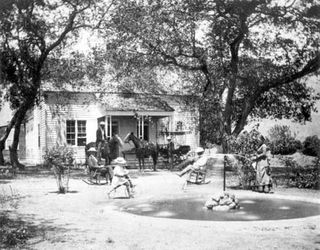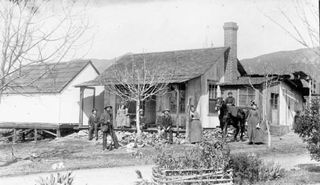
presented on the occasion of the dedication of the newest AHA! (Altadena Heritage Area), the Equestrian Block, Oct. 19, 2013, at Altadena Stables.
All photos: Altadena Historical Society.
The ground beneath us has history. Not just human history, but horse history. Humans, in fact, were in the minority at the beginning of the recorded history of this patch of land — an outwash plain of the San Gabriel Mountains between the Arroyo Seco, here to the left of Altadena Stable, and Eaton Canyon a few miles to the east.
The future Altadena was prime pastureland belonging to the San Gabriel Mission, established in 1771. It grew to be the richest and most productive of all 21 California Missions, controlling about 1.5 million acres from San Pedro to Mount San Grigornio. During the winter many of the hundreds of horses belonging to the mission pastured up here, and they multiplied. They had a role in altering the land and environment, along with cattle, sheep, chickens, dogs, and humans.
I came across an intriguing reference contributed by Jeanne Carr to a 19th Century history of LA County, to a “Belle Mare. . . the fleetest and most beautiful of the Padre’s stock, who led a band of wild horses to Altadena” in winter, where they pastured on the luxuriant crop of grasses.
Our local Indians, who learned to be great horsemen, used the trail beginning right here that led into the Arroyo and through Millard Canyon that was a major connecting route to their trade highway across the mountains, to the east and south. Gabrielinos were great traders, and dealt in such goods as baskets and tar from the La Brea tarpits, which has been found as far east as the Mississippi River.
A Yankee pirate taken prisoner at the end of the Spanish period, around 1818, Joseph Chapman, felled logs above Millard Canyon and dragged them with mule and ox teams down to the pueblo of Los Angeles to be made into beams and boards that build the church that still stands on the north end of the Plaza at Oliveras street.
In the Mexican era, the 1820s to 1846, when cattle ranching outpaced everything else as California’s main economic driver, the Californios developed the reputation of being the finest horsemen in the world. They had over 200 words just to describe different types of horses, and at rodeos and Fandangos demonstrated incredible equine skills. We will see a little of that later today.
The role of horses barely diminished with statehood in 1850, but it did tone down to artistically dominate in the culture less. But still horses and mules remained the most important transportation mode.
A free black man Robert Owens settled in the hills right behind us in 1855, and made a living harvesting firewood and building materials from the forest and supplying the US Army. He carried these to Los Angeles on horses and mules. He soon bought his family’s freedom, moved to Los Angeles, and opened a stable there on First Street during the Civil War.
Ben Eaton built the first frame house in the San Gabriel Valley around the same time, for the widow of the Confederate General Albert Sidney Johnson, over by the canyon that eventually bore his name. He moved here shortly thereafter, when walking and riding were still the only means of transport. No train connections here until the 1880s and 90s. Altadena was not yet Altadena, and we still had some major predators in grizzly bears, plus lots of rattlesnakes. But Ben Eaton’s Yankee wife Alice from Rhode Island was apparently ready to face these dangers, even though the family lost a few of its favorite horses to bear attacks. She found our local predators less threatening than those at the many bars and brothels of Los Angeles, watering holes such as the Bella Union Hotel, where her husband used to hang out drinking with a powerful core of southern sympathizers plotting for Southern California’s secession from the Union.
That awful war settled that. California, along with the rest of the country, would be a nation of free labor. Soon after, mostly Union sympathizers and abolitionist-leaning settlers from the midwest began coming to the Pasadena/Altadena area. The Giddings family were among the first, settling here by 1875. I believe we are on ground today that included their holdings. Their house was roughly where Loma Alta park is today. And they planted the grape vines that gave La Vina its name. Mrs. Giddings would know it was time to start dinner when husband Levi’s horse or buggy dust would start a little puffy track she could follow as he rode up across the empty plain from the recently established Pasadena.
When the Giddings family built Mountain View Cemetery in 1881, it was among the first “park-style” non-denominational cemeteries, as opposed to traditional churchyard or synagogue burial grounds. The idea was that you could ride up on your horse, or horse and buggy, and picnic while placing flowers on dearly departeds’ graves.

Of course with modernization and industrialization, the horse’s importance has decreased. But Altadena, more than most places, has always made room for and welcomed horses. Because of our proximity to the mountains and trails, and because we are lucky to have many large residential lots and a county government that is quite friendly to horses, we are lucky here to remain among them. To see equestrians clip-clopping along Altadena Drive, up Cassitas, across Mountain View Street, or to meet them on the trail, is a quintessentially Altadena experience. Altadena Stables is the longest running public operation. When I was a kid I rode both at Eaton Canyon Stables and up at the Zorthian Ranch. Eaton Canyon Stable is gone, and horseback riding lessons are no longer available at Zorthian Ranch.
Our MC today, Karin Bugge, will tell us a bit more about this particular place, so I’ll end here with a word of appreciation for everyone who keeps the equestrian tradition alive here, Desdy Kellogg especially, and all those who keep on riding and giving us all the pleasure of seeing these magnificent animals every day as we go about living in Altadena.






